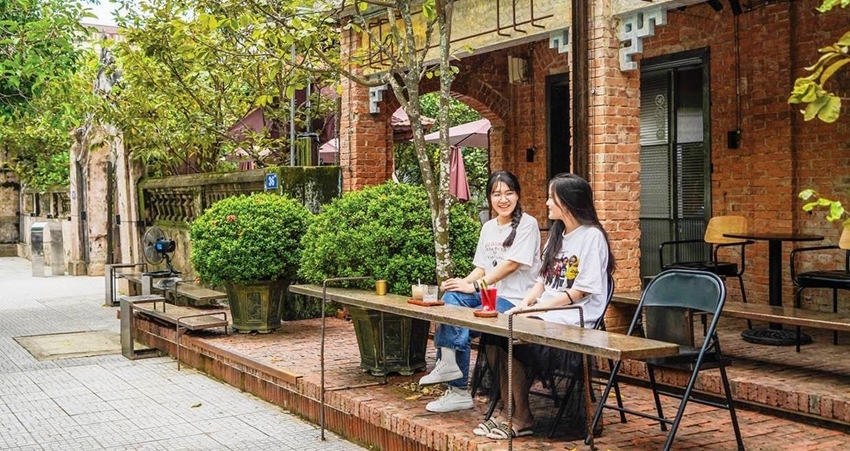Entering those places, you will have a nice surprise to see that their lives behind royal-looking gates were also modest, unlike what people thought about them.
 |
| Clients enjoying coffee at the cafe located on campus of Phu Quoc Cong (Quoc Cong’s Residence.) |
It was a Saturday morning. We friends had an appointment at the cafe on Nguyen Phuc Nguyen Street, Kim Long Ward, Hue City. “Let’s imagine; about one hundred years ago, laymen like us were not allowed to enter this residence,” joked I. “Then let me imagine; I were a noble girl going with my father to visit my relatives here,” laughed my friend.
We all laughed while entering the cafe through the light pink gate.
The fact that these ancient residences still have their ancient gates left is rare. Many ancient gates were gone when streets were widened. Among many modern houses without gates or those with new modern gates, this charming ancient mossy curved gate adds to the unique beauty of Hue City. Just a few seconds of passing by, people are impressed with peacefulness as a reminder of the past.
The main house is a Hue beam house, a long way further from the gate. Compared with the garden, the house is always much smaller in surface area.
“Opening these cafes on campus of Phu De is like opening “closed-gated and high-walled” houses in ancient Hue,” said I wittily.
It is still a traditional beam house in front of which is a guarding screen to keep people from looking into the house, and also to prevent bad things from entering the house according to feng shui. The house is located in the center of the garden with the roof being not allowed to be higher than the old trees in the garden. It is said that it is its location in nature and the respect for nature that has gradually formed a humble lifestyle and the love for nature of Hue people, hence their sense of protection of nature.
In that coffee morning we talked much about the “green topic” such as the green spots in the city and at home gardens, and the green lifestyle of Hue people, especially city dwellers. The heritage of Hue gardens helps Hue City maintain green spots at the time when “land is golden.”
Many ancient garden houses in Hue have changed a lot. Their land is divided for children to build their own houses when they are married. Fortunately, since they are used to living with plants and trees, their eyes to the green color, Hue people always give priority to trees and plants though they now live in smaller houses. In any situation, flowers still bloom, leaves are still green in newly-styled houses. It is not an effort, but simply a habit and a familiar way of life.
I am thus in agreement with people who says “Hue people’s lifestyle with nature is heritage itself.” It is the spiritual heritage of the people in this region.
During my visits to Phu Cong chua Ngoc Son (Princess Ngoc Son’s Residence,) Mr. Phan Thuan An, a descendant of the princess, said: “The garden house is a place where Hue people cherish all their love and responsibility for their families, and also the place for them to prove their philosophy of life, ideology and morality.”
It is therefore not strange to see parallel sentences everywhere from the gate to inside the house, on the gate, the guarding screen, etc. Decorative patterns depict traditional flowers and plants such as apricot blossoms, orchids, chrysanthemums and bamboos, and reveal their desires about studies, virtues, love for nature and living with nature.
Recently-opened cafes on campus of Phu De, ancient Hue garden houses are a way to bring the heritage to life, specifically to earn money from the heritage to conserve the heritage itself.
Those who reside in old garden houses know keeping a garden house clean and green costs lots of energy and money. Preventing it from humidity, leaking and termites needs a big budget. Ancient beam houses have flat-tiled roofs. That kind of tile is now expensive and it costs much to have them replaced every a few years.
Weeding every month is another problem because weeds grow very fast. They cover again just after one month. In summer, in order to keep the garden always green, it must be watered thoroughly.
“Everything costs money. I'm old and without pension. I just rely on relatives who send money back for taking care of the garden and mending the house. Weeds grow very fast,” said an old woman in Kim Long who is taking care of the house left to her by her ancestry.
“I just hope this type of garden cafe works well. The owner invested lots of money in this beautiful garden for clients. Located on campus of Phu De, the cafe needs to do justice to. It must be unique,” said my friend, well aware of difficulties of investing in the heritage to conserve the heritage.
"Fortunately, he works in the culture field. He knows how to invest, exploit, conserve and promote the value of the heritage,” said I, hoping the exploitation of Hue ancient garden houses will be done with understading and the love for their ancestry.
Opening these “closed-gated and high-walled” houses is for the heritage to live its everyday life. Though it is certainly not a bed of roses.
